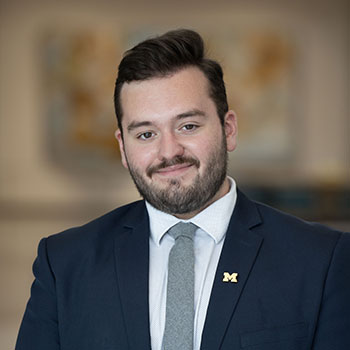
Researchers share innovative ideas in concrete for a more sustainable future
Speakers at the symposium “From Lab to Site: Innovation in Concrete” discussed climate change, 3D printing, “smart” buildings, research potential and collaboration.

Speakers at the symposium “From Lab to Site: Innovation in Concrete” discussed climate change, 3D printing, “smart” buildings, research potential and collaboration.

The Department of Civil and Environmental Engineering (CEE) and Taubman College of Architecture and Urban Planning co-hosted a symposium on October 31 and November 1. “From Lab to Site: Innovation in Concrete” featured speakers from numerous disciplines, institutions and countries, and was held at Taubman College in the Art & Architecture Building.
Organized by Tsz Yan Ng, Assistant Professor in Architecture and Wes McGee, Associate Professor in Architecture and Director of the FabLab, the event brought together experts in the fields of engineering, architecture, history and theory, construction technology, design, and manufacturing. Despite the range of expertise, there were intersections across the panels, highlighting the importance of interdisciplinary synergy when it comes to working with concrete, a widely-used material that carries immense potential for reducing embodied carbon in our built environment as well as advancing building sector innovation. Concrete literally shapes the cities we live in, inspiring how we design for the future.
Indeed, collaboration and inspiration were stressed throughout the symposium; keynote speaker Sarah Billington noted during the panel that charted research trajectories that she was inspired to go into academic research after hearing a talk by CEE Professor Victor Li on Engineered Cementitious Concrete (ECC). Li and fellow CEE Assistant Professor Brian Ellis spoke to the urgency of combating climate change in their talk, “Bendable Concrete for Resilience and Sustainability of the Built Environment,” detailing the research and development of ECC or “bendable concrete,” which is 300x more ductile than traditional concrete and can “self heal” after straining.
Additionally, Li and Ellis noted the potential for carbon utilization through ECC, which is vital given the construction industry’s role in contributing to global carbon emissions. Processes like carbon sequestration in concrete help to shape resource flows for a more sustainable way to build moving forward. Bendable concrete is just one of many research projects being conducted by the Global CO2 Initiative at the University of Michigan, which seeks to develop and implement sustainable and economically-viable solutions for carbon neutrality.
Other major challenges discussed were the protocols and regulations required of traditional building practices, as noted by Cornell Professors Kenneth Hover and Sasa Zivkovic. Several panelists, such as Barton Malow’s Matt Hedke, highlighted that the industry has not kept pace with technological innovation, and others, like The Heyman Center’s Maria Gonzalez Pendas and Columbia University’s Ateya Khorakiwala, emphasized the importance of recognizing both the roles laborers played historically and their assumed safety risks in the strive for innovation.
Hedke and CEE Professor Vineet Kamat presented on construction robotics, automation techniques and 3D printing. The latter was a popular topic among panelists, with many speaking on the potential for 3D printing technology to automate construction and how that, in turn, has the potential to affect how we design buildings in the future. Pennsylvania State Associate Professor of Architecture Shadi Nazarian and Jacobs Space Exploration Group’s Michael Fiske considered future designs for 3D Printing in outer space, presenting their research for NASA’s Centennial Challenge, and how we may one day be 3D printing buildings on Mars.
Similarly, Taubman College’s Mania Aghaei Meibodi and PERI Group’s Fabian Meyer-Brötz explored discussed utilizing additive manufacturing to create lightweight concrete components and geometrically-intricate buildings. With the widespread enthusiasm for concrete 3D printing worldwide, there is much to innovate for this process; faculty and students from CEE and Taubman College are developing several projects involving CEE’s new robotic fabrication lab that will contribute to the growing body of research in this area.
The day ended with an exhibition opening reception at the Liberty Annex Research gallery featuring work by the symposium’s participants, including Li’s 3D-printed concrete and “Patty and Jan,” a performance of megalithic assembly produced by Matter Design and CEMEX Global R&D.
This symposium marks an important moment of innovation and collaboration across related disciplines.
Closing the symposium, CEE Department Chair Jerome Lynch noted, “When we come together as a community and we look at how to evolve a material, it’s amazing what we can do.”
Presentations from the symposium “From Lab to Site: Innovation in Concrete” were recorded. Those who were unable to attend or are interested in rewatching can now access the videos online.

Marketing Communications Specialist
Department of Civil and Environmental Engineering